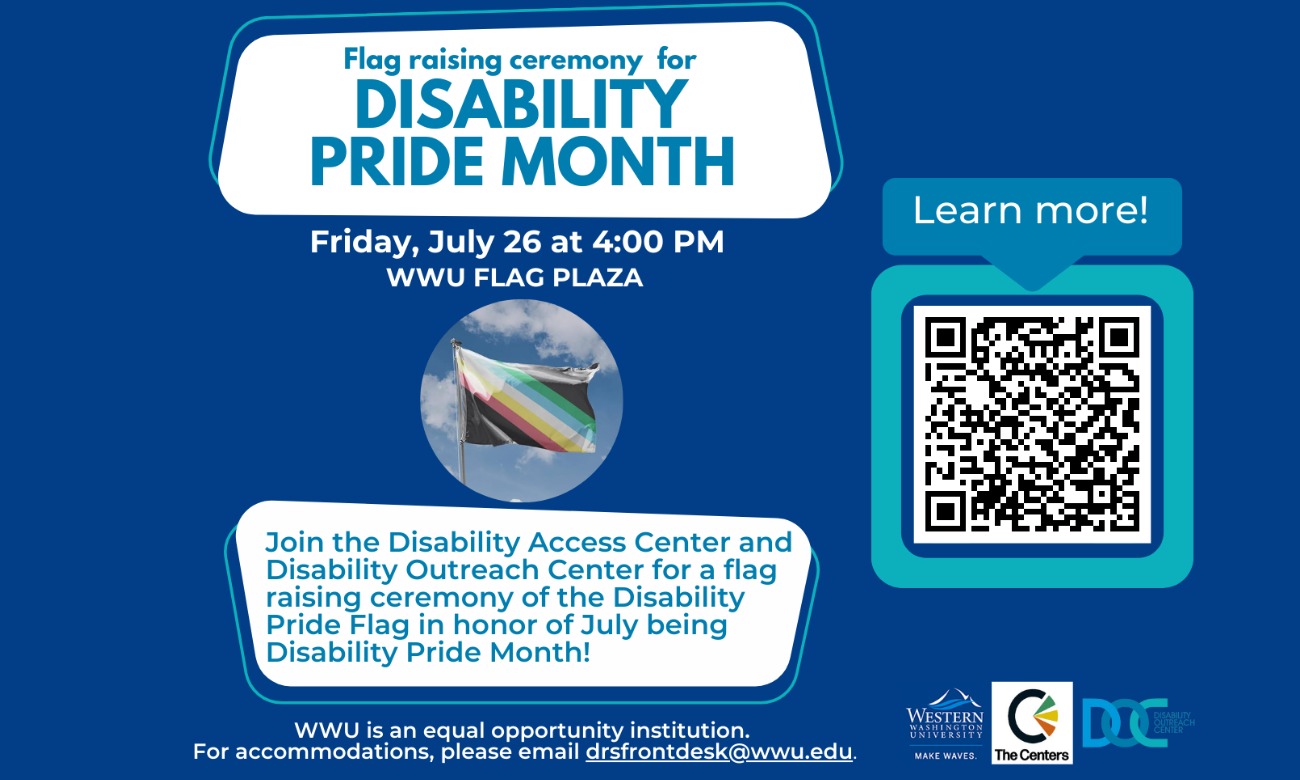Disability Pride Month: Disability Pride Flag Raising
Featured image

Description
Disability Pride Month is celebrated every July and is an “opportunity to honor the history, achievements, experiences, and struggles” of the disabled community (The Arc, 2024). It marks the anniversary of the Americans with Disabilities Act (ADA), passed July 26, 1990, the landmark legislation that broke down barriers to access and inclusion in society (The Arc, 2024). 2024 also marks the 51st anniversary of the 504 Sit-In and passage of Section 504 of the Rehabilitation Act, the first federal civil rights protection for disabled people (Disability Rights Education & Defense Fund, 2024).
This year, Western Washington University (WWU) will recognize Disability Pride Month with the raising of the Disability Pride Flag over Flag Plaza on Friday, July 26, the anniversary of the passing of the ADA. Join us in recognizing Disability Pride Month at the Disability Pride Flag Raising on Friday, July 26 at 4:00 PM at WWU Flag Plaza.
People with disabilities are the largest and most diverse minority, representing all ages, races, ethnicities, socio-economic backgrounds, genders, sexualities, and religions (Langtree, 2024). The Disability Access Center serves over 4,000 disabled students each year, nearly 20% of the student population. Additionally, the Disability Outreach Center provides spaces and programming that promotes community building and disability pride and offers education and peer-to-peer support, reaching students with and without accommodations.
The Significance of the Disability Pride Flag
The Disability Pride Flag, designed by Ann Magill, a writer with cerebral palsy, is the symbol of the disability pride movement. The original Disability Pride Flag, which featured brightly colored zigzagging stripes over a black background, was created by Ann Magill in 2019. Ann Magill had “attended an event for the 20th anniversary of the ADA and was disappointed that it was confined to the basement and grounds of an independent living center — instead of out in public. The experience motivated her to create a Disability Pride Flag” (Columbia University, 2023). As she explained in an interview on The Accessible Stall podcast, "My first design idea was to make the stripes zigzag, to represent how disabled people have to maneuver around all the barriers we face. We have to go this way and then we have to go that way, and then we have to go this way and then we have to go that way. And that’s how we move through the world." However, it came to Ann Magill's attention that “when viewed on a phone or computer screen, the design was causing symptoms for individuals with visually triggered disabilities including seizure and migraine disorders” (Ballard, 2023). The redesigned version of the flag, created by Ann Magill in 2021 in collaboration with several people with visually triggered disabilities, softens the colors and made the stripes straight instead of zigzagging. The order of the stripes was also changed to accommodate people with red-green colorblindness (Magill, 2022).
The visually safe Disability Pride Flag features a muted black background with a diagonal band from the top left to bottom right corner, made up of five parallel stripes in red, gold, white, blue, and green. Each element of the flag carries meaning for the disabled community:
- Faded Black Background: Represents "the anger and mourning over the eugenics and the neglect that disabled people have to fight against,"
- Six "Standard" Flag Colors: Represents that the disabled community “is pan-national, spanning borders between states and nations,”
- Red Stripe: Represents physical disabilities,
- Gold Stripe: Represents neurodivergence,
- White Stripe: Represents non-apparent disabilities and undiagnosed disabilities,
- Blue Stripe: Represents emotional and psychiatric disabilities,
- Green Stripe: Represents sensory disabilities, including d/Deafness, blindness, lack of smell, lack of taste, audio processing disorder, and all other sensory disabilities (Magill, 2022).
Why It Is Important
Raising the Disability Pride Flag brings visibility to the disabled community. It serves as a reminder that people with disabilities are an integral part of our society, including at WWU. The flag symbolizes pride for the accomplishments and contributions of disabled people, including our disabled students, faculty, and staff. As we celebrate Disability Pride Month, let the raising of the Disability Pride Flag over WWU serve as a reminder of our past and celebration of the present while we work towards a more accessible future.
AA/EO. Accessibility Statement:
This event is intended for all participants, including those with apparent or non-apparent disabilities. For disability accommodation(s) (such as ASL interpretation), please contact the Disability Access Center at drsfrontdesk@wwu.edu. Advanced notice is appreciated and sometimes necessary to arrange for some accessibility needs.
WWU Flag Plaza is on South Campus Drive located between Wade King Student Recreation Center and the Academic Institutional West building. Please refer to the Campus Map and select the ‘Accessibility’ filter for information about the nearest accessible parking spots and accessible routes.
Image description:
Blue background with a white rectangular shape surrounded by a light blue line containing text in the top center. The text is a lighter blue and reads, “Flag raising ceremony for Disability Pride Month,” with Disability Pride Month in all caps. Underneath is white text that reads, “Friday, July 26th at 4:00PM” followed by “WWU Flag Plaza” in all caps. Beneath the text is a circular image of the visually safe disability pride flag against a cloud-filled blue sky. Another white rectangular shape surrounded by a light blue line is directly below it with light blue text reading: “Join the Disability Access Center and Disability Outreach Center for a flag raising ceremony of the Disability Pride Flag in honor of July being Disability Pride Month!” Below that is white text that reads “WWU is an equal opportunity institution. For accommodations, please email drsfrontdesk@wwu.edu.” On the right side is a QR code with a light blue boarder with text above it in a darker blue speech bubble that reads "Learn more!". Below that in the right corner are the WWU, Centers, and DOC logos.
